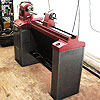I purchased the Domino today (But went home with the shop one tell mine arrives on Tuesday). And was trying to make a 12 X 18 top out of Poplar. After a little trial and error I got really precise tenons cut. When dry fit my first set the Domino was so tight I could not remove it from the hole. I then cut the tenons in the 3 Poplar planks and started gluing them up. I had a really hard time squeezing the boards together cause of the tight fit. I ended up having to use 2 pipe clamps and 3 Bessie clamps and had to work hard to get the gaps closed up. On the first attempt I had one of the pieces curved a lot. After that attempt I cut the Dominos out and started again. I took much more care in getting the pieces flat the second time but still needed to torque the clamps pretty hard to close the gaps. I ended up getting the piece flat but in the process I ended up twisting the board. If someone could lend me some assistance in making wider pieces with the Domino I would appreciate it.





 Reply With Quote
Reply With Quote











